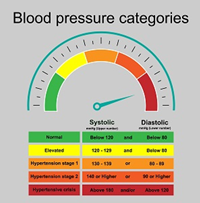Hypertension Biofeedback and Neurofeedback Protocols
According to the American Heart Association web site statistics, almost half of the adult population in the United States of America can be considered to have high blood pressure. A hard to believe 45 percent of those who have hypertension do not have it adequately controlled. That sounds pretty terrible to me. Even with all of the medications that are prescribed such a low number of people have their blood pressure under control. Many people are even prescribed 2 or 3 or even more blood pressure medications to attempt to bring the levels to an acceptable level. This tells me that it is not a simple problem. Medication alone may not be enough to normalize blood pressure. Even when medication does normalize blood pressure it may not be the best long-term solution. There are many things that can elevate blood pressure that should be addressed in order to help normalize blood pressure.
Here is a link to a PDF file that lists and discusses things that could increase blood pressure, Blood Pressure Raisers, Learn what could raise your blood pressure: https://www.heart.org/-/media/files/health-topics/high-blood-pressure/tylenol-hbp/bp-raisers.pdf?la=en
It mentions things like sodium, caffeine, alcohol, antidepressants, decongestants, amphetamines, and corticosteroids.

You could also add smoking, obesity, and a sedentary lifestyle to the list.
There are many applications that biofeedback and neurofeedback are used for. Effectiveness varies for different conditions. There is a document titled Evidenced Based Practice in Biofeedback and Neurofeedback, which is available from the Association of Applied Psychophysiology and Biofeedback, AAPB, aapb.org. The latest edition is 2016. There are 2004 and 2008 editions floating around on the internet in PDF format. You can purchase the latest 2016 edition at aapb.org. It rates biofeedback efficacy on a scale of 1—5, 1 being the least effective and 5 being the most effective. Biofeedback for hypertension has a rating of 4 which is a very good rating, up there with tension and migraine headaches and ADHD.
With such a high rating biofeedback should be used for helping people with hypertension. As a middle aged African American man with both parents having hypertension, I am in a high-risk population for hypertension myself and have a great interest in the area.
Biofeedback for hypertension is not new, I think it is just not talked about much and underutilized. Let’s look at some history.
A Menninger Foundation study that used sEMG and skin temperature biofeedback with breathing training and relaxation, resulted in 65% of subjects completely discontinued medication while reducing their blood pressure 15/10 mmHg to an average value of 128/80. Another 24% of the subjects reduced their medication by one-half while reducing pressure 17/12 mmHg.
The biofeedback portion of this simply involves teaching a person to relax their muscles thus decreasing their sEMG levels and increasing their skin temperature which goes along with dilation of peripheral blood vessels in the hands and feet. Larger openings for blood to pass through results in a decrease in blood pressure or resistance.
This research was done in 1986. There has been additional work with hypertension since then. One of the newer protocols uses HRV or Heart Rate Variability biofeedback. With HRV biofeedback, paced breathing, preferably at a person’s resonance frequency or ideal breathing rate is used to cause the Barro reflex to decrease blood pressure. There are several measures of HRV that can be fed back and trained, including RSA (respiratory sinus arrythmia), HR Max-Min, coherence, smoothness, or simply increasing LF (Low Frequency) power depending on which device and software you are working with.

The RESPeRATE device which provides a form of guided breathing exercises has also been shown to lower blood pressure. The results from 13 clinical trials, with over 600 people with hypertension, found that using the RESPeRATE device for 8 to 9 weeks reduced blood pressure by an average of 13/7mmHg.
The other suggestion for a neurofeedback protocol to reduce blood pressure is training to increase alpha in the parietal or occipital areas.
Increased alpha tends to go along with brain quietness. This is similar to what we expect during meditation. When we close our eyes visual input stops so our brain does not have to process the information it does when our eyes are open. It should be in a more relaxed state because it isn’t working as hard. If a person is still thinking a lot with their eyes closed then their alpha doesn’t increase as much because their brain is not really resting.
Training to increase alpha can help the brain become relaxed which also helps to relax the body. Research has shown that regular meditation can decrease blood pressure. Alpha training should do the same.
Harry L. Campbell
914-762-4646 – Harry@biofeedbackinternational.com
Author of What Stress Can Do, Available on Amazon.com
Biofeedback Resources International Corp.





